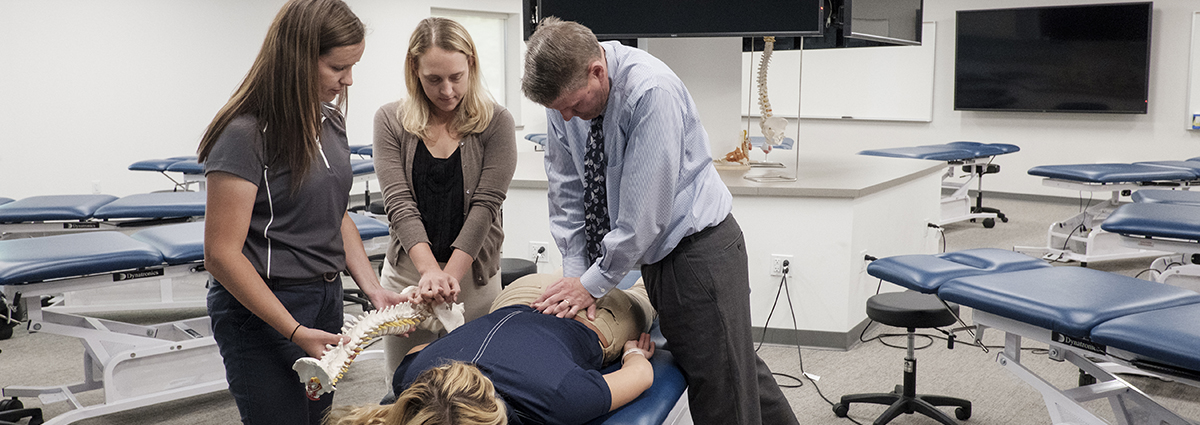State of the Art
In its first five years, Moravian’s Department of Rehabilitation Sciences has enjoyed a meteoric rise to prominence among graduate programs in its field. The future promises to be equally exciting.
By Claire Kowalchik
Photographs by Theo Anderson, Ryan Hulvat, and John Kish IV
When the Sports Medicine and Rehabilitation Center opened on March 23, 2016, inside you would find classrooms, labs, offices, a clinic managed by St. Luke’s University Health Network, and unfinished space on the second floor. The fledgling Department of Rehabilitation Sciences had a single to-be-accredited graduate program in athletic training and two faculty members—James “Jay” Scifers, program director of rehabilitation sciences and department chair of athletic training; and Jennifer Ostrowski, who is today the associate professor and director of athletic training. And on May 31, 2016, seven students would show up to begin their work toward a master’s degree in athletic training.
Today, five years later, the department offers six graduate programs:
- Master of science in athletic training (MSAT)
- Master of science in occupational therapy (MSOT)
- Master of science in speech-language pathology (MS-SLP)
- Doctor of athletic training (DAT), an online program
- Doctor of physical therapy (DPT)
- Dual DAT-MBA program, the only one in the country
All are accredited except the DPT, which launched this year and is targeted to receive accreditation in the fall of 2023.
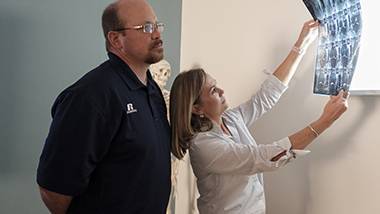
Athletic training students examining an X-ray
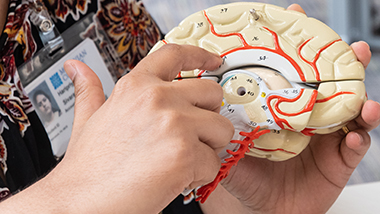
A model of the brain
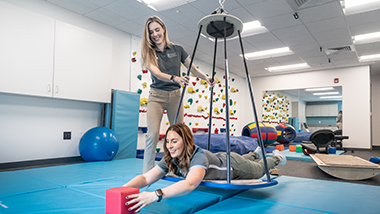
Trying out the equipment in the pediatric lab
The faculty has expanded from 2 to 22 nationally recognized full-time members, who are supported by two full-time staff members. Roughly 50 specialized adjunct professors complete the faculty roster.
Labs and classrooms have now filled out the second floor of the world-class center, and additional state-of-the-art equipment has been installed. “We purposely left the second floor unfinished,” says Scifers, “because when we opened, we didn’t have faculty in OT, PT, or speech-language pathology, and we wanted input from them.
In the beginning, the first floor housed a research lab, an orthopedic assessment lab, a therapeutic modalities lab, a functional rehabilitation lab, practical exam rooms, and classrooms— including one equipped with microphones, speakers, and a screen that allows experts from anywhere in the world to engage with students remotely.
With the input of OT and SLP faculty, the second-floor space, which opened in August 2019, boasts several new research labs:
- A home simulation lab
- A splinting lab
- An adult neurology lab
- A pediatric lab
- A speech, voice, and swallowing lab
- Problem-based learning classrooms
Problem-based learning classrooms are small and equipped with white boards to facilitate collaboration among groups of eight students. “Ours is the first and only SLP program in the United States to follow a problem-based learning curriculum,” says Louise Keegan, program director of speech-language pathology. “This means that the bulk of the curriculum is delivered through case studies, so students learn content by working through these cases in groups. They have the opportunity to immediately consider how their academic knowledge is clinically applied.”
Priyah Mehrish
Master of Science in Athletic Training
Class of 2019
Priyah Mehrish G’19, is an assistant athletic trainer at Rider University, primarily working with cross country teams and the men’s basketball team. She is the mental health liaison for athletics, and she works with a nutritionist as a resource to Rider’s student-athletes and teams. Mehrish took the initiative to convince Rider’s athletic director to sign off on getting the entire athletics faculty certified in mental health for adults.
“I may go back to school,” she says. “I don’t feel I am done with formal education. If I do, I will go back to Moravian. I am familiar with other athletic training programs, and none come close to Moravian’s.”
“The faculty at Moravian are amazing, passionate educators who are invested in students. You can tell that it is not just a job for them. They really push you to be the best. Learning from them was so rewarding even though it was hard. And after you leave, they continue to check in. I don’t know if I would have achieved what I have if it had not been for them.”
Further enriching learning, the rehab sciences department added several pieces of advanced equipment to teach patient treatment and assessment:
- A driving simulator that helps older adults get back to driving after a concussion, stroke, or other brain injury
- A biomechanics system that allows students to do an analysis of a patient’s movement
- A mat for measuring foot pressure—as a patient walks across the mat, students can see how that patient’s foot pressure changes and deduce how that might impact injury
- A NeuroCom, which helps assess balance in patients who’ve had concussions, head injuries, and strokes
- An audiology booth for students of speech-language therapy to perform hearing tests
- A stroboscopy tower for voice and swallowing evaluation
Moravian students also have access to special equipment in the St. Luke’s clinic, such as the antigravity treadmill, which helps patients regain their walking and running mechanics without impact.
Take a tour of the Sports Medicine and
Rehabilitation Center through this video: mrvn.co/smrc.
Tyler Countess
Doctor of Physical Therapy
Class of 2023
Tyler Countess ’16 G’18 will be the first student to earn his bachelor’s, master’s, and doctoral degrees in health sciences and rehabilitation at Moravian.
After graduating in 2018 with his MSAT, Countess joined St. Luke’s team of athletic trainers and worked as needed at three different area schools. When a position opened up at Easton High School, with among the biggest and best sports teams in the area, he was thrilled to be offered the job and he loved it. But game schedules change, and as an athletic trainer you get last-minute calls to attend a game not on your calendar. Countess wanted a career with a set schedule. Moravian’s DPT program launched at the right time.
“I’d like to work in an orthopedic physical therapy setting, pediatrics or neurology perhaps,” Countess says. “Orthopedics is what I’ve done as an athletic trainer, and I love it. I love to work with patients and help them get better.”
“The interdisciplinary education is a hallmark of Moravian’s programs in rehab science. You get to know the students in the other disciplines, and it’s invaluable to have that interprofessional experience—learning how to work together before you actually do.”
The Brilliance
Our Sports Medicine and Rehabilitation Center is a world-class facility, but what makes our graduate program shine above all others is the seamless interprofessional education. “We are the only school in the country that has this mix of programs—athletic training, occupational therapy, physical therapy, speech-language pathology—all in the same department and under the same roof,” says Scifers. “Typically, what you see at other schools is that these programs are stand-alone departments and physically in different locations, so collaboration becomes more difficult. We have purposely built interprofessional education into our students’ experience.”
Teams are formed with students from every discipline: athletic training, physical therapy, occupational therapy, and speech-language pathology. Once a month, each team must work together on a case study, and in so doing, they educate each other.
The experience mimics what happens professionally. For example, an athlete whose injury on the field includes a concussion will see an athletic trainer and, depending on the severity of the injury, may also need to see a physical therapist, an occupational therapist, and a speech-language pathologist.
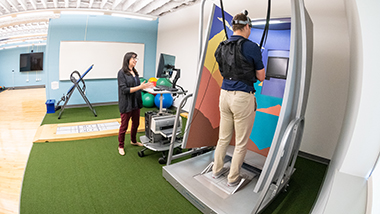
The NeuroCom, used to assess and treat balance issues
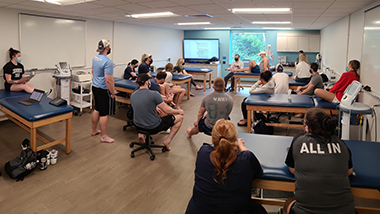
A physical therapy class
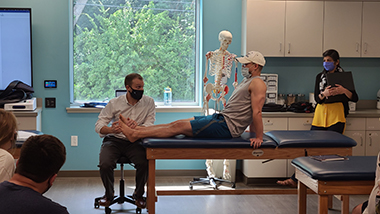
Demonstrating technique in athletic training
“This kind of collaboration happens at other institutions, but our system is more formalized,” says Scifers. “Students stay with the same team the entire time they are here, so they build those relationships. First-years are just dipping their toes into the professional experience. Second-years are becoming licensed professionals, so they are at the point where they are educating others about what they do.”
That interprofessional education is significantly enriched by the partnership with the St. Luke’s clinic. The clinic specializes in sports medicine, physical therapy, and orthopedic care, and students can simply walk down the hall or down the stairs to observe practicing professionals. Those professionals also come into classes to give guest lectures, and St. Luke’s offers clinical placements to our second-year students.
The clinic also enjoys the benefit of being neighbors. “Moravian’s department of sports medicine and rehabilitation sciences is an educational resource,” says Matthew Johnston, director of the St. Luke’s clinic. “We do lots of collaboration on research, particularly in injury prevention. We screen athletes to identify those who are more at risk of injury and work on therapies that will prevent injury, and that work has expanded from cross-country runners to including baseball and soccer players.”
“We have a nice synergy,” says Scifers. “The relationship with St. Luke’s is invaluable. It’s a strength of ours. Institutions with medical schools have this connection, but for a school our size to have such a close relationship with a healthcare network is rare.”
Ashley Gray
Doctor of Athletic Training
Class of 2020
Ashley Gray G’20 is an instructor of the exercise science and rehabilitation therapy program at Central Montco Technical High School in Plymouth Meeting, Pennsylvania. In addition, she is an adjunct professor at Westchester University for its MSAT program and at Delaware Tech community college for pathophysiology, anatomy, and physiology.
When the doctoral program in AT launched, she looked into it. “I saw who the faculty were and thought, Wow, they are all prominent people in athletic training,” says Gray. “The program exceeded my expectations. It isn’t just drilling facts into your head; it is collaborative. We would independently do research and then discuss why a particular problem was occurring and how we should address it. This is the best way to deliver a DAT program, because at this point in our education, we don’t need to study or memorize anything.
“I hated research when I came in, but Jennifer Ostrowski took me under her wing. I presented at the National Athletic Trainers Association Conference on concussions in the pediatric athlete and whether there might be a connection to depression. Research is not something I had in my wheelhouse, but the faculty at Moravian encouraged it and opened a door for me.”
The Success
Building a nationally renowned faculty, state-of-the-art facilities, an ideal structure for interprofessional learning, and collaboration between clinicians and educators has been a formula for success. Despite the pandemic, the department has met expectations in terms of enrollment. Moravian sees a steady and robust flow of applicants. For the upcoming admissions cycle in occupational therapy, 200 to 300 applicants are expected for 30 spots (acceptances are set by accreditation and by limits in clinical education).
The excellence of Moravian’s Department of Rehabilitation Sciences has also boosted undergraduate enrollment. Prospective students see the value of pursuing their goals at Moravian where undergrad tracks in health sciences lead directly into graduate programs, which speeds degree completion.
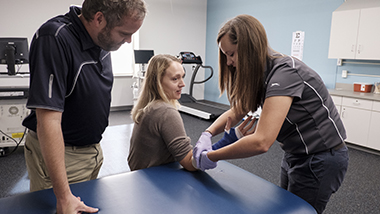
Demonstrating technique in physical therapy
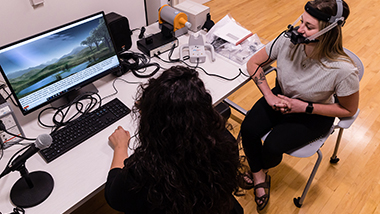
Speech-language pathology students use a nasometer to measure how much air comes out of the nose versus the mouth when speaking.
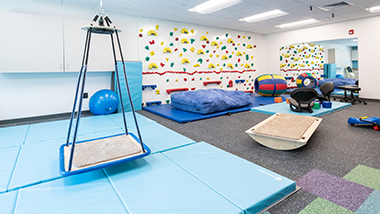
The pediatrics lab combines work and play.
“Health sciences has the largest enrollment of all undergraduate programs at Moravian,” says Scifers. “The target for enrollment was 30 students by 2020, and we’re over 200. For the 2016–17 academic year, about 10 students enrolled in health sciences. Today, 50 to 60 students are coming in as freshman interested in health sciences, and another 10 are transitioning from other majors.”
Of course, the true success of any academic department or program lies in the success of its students. “Our current students and alumni have been successful in getting articles published and conference presentations accepted, as well as winning state, district, and national scholarships,” says Ostrowski.
For all programs, 100 percent of students have passed their boards, 100 percent have become licensed, and 100 percent are employed in their fields.
Cailee Carmella
Master of Science in Speech-Language Pathology
Class of 2022
After graduating next May, Cailee Carmella plans to work, and sometime in the next five years, she will pursue a doctorate focusing on bilingual language acquisition and speech services for bilingual and multicultural populations.
“The speech-language therapy program has been such a great experience,” says Carmella. “It has helped me grow as a researcher, as a clinician, and as a self-guided life-long learner.”
“Moravian offers the first problem-based learning program in the country. We work in groups of eight and are given a case every week. Our job is to determine what we need to know about that client and gather evidence-based research based on that background. We then determine how we would carry out the assessment and treatment. We make a whole plan from start to finish.”
“We’ve heard from so many outstanding speakers. One of the most highly published experts in the field of stuttering was with us for the first two weeks of this semester. She brought in NBA player Michael Kidd-Gilchrist, who talked about his experience with stuttering.”
The Future
The momentum continues. Moravian University offers a master’s degree in clinical counseling and is working to develop a new department in behavioral health, which will include counseling. Other programs being considered include a master’s in social work and a doctor of science in psychology.
“This is part of President Grigsby’s vision to build a program focused on training more students to meet the mental health needs in the Lehigh Valley,” says Daniel Jasper, dean of the School of Arts, Humanities, and the Social Sciences. “We are working with partners—St. Luke’s University Health Network, Bethlehem Area School District, Intermediate Unit 20—to both understand the needs of our community and develop curricular pathways to prepare the next generation of professionals to meet those needs.”
Jonathan Anthony
Master of Science in Occupational Therapy
Class of 2021
Jonathan Anthony ’19 G’21 wants to work in a skilled nursing facility where his talents will shine. He likes working with older adults and teaching them basic activities of daily living like how to dress themselves, cook, or do their finances. And he’s been using his skills with a family member who has mild age-related cognitive deficits that occasionally make it difficult to engage in certain activities. During a visit a few months ago, he provided adaptive methods for using the computer and TV and gave recommendations for rearranging cluttered areas of the house to reduce potential fall risks.
“The faculty at Moravian are phenomenal,” Anthony says. “I am grateful for how rigorous they were in making sure we were prepared for becoming knowledgeable, holistic, and ethical therapists once out in the field, upholding the core tenets and mission of occupational therapy. We did a lot of clinical simulations and had the opportunity to provide services to community members, which really helped us in honing our skills as budding therapists. I am very confident in my abilities.”
And what does this have to do with athletic training or rehabilitation? The mental health of athletes has headlined many major media stories in recent years. It is part of the athletic training curriculum we offer, and much of Ostrowski’s research addresses the psychology of injury. But the behavioral health disciplines will also serve interprofessional education and collaboration, the hallmarks of our Department of Rehabilitation Sciences, which prepares our students to be the best healthcare providers. “Often in our case studies, we wish we had a social worker, counselor, or nurse on our teams,” says Scifers. “In healthcare, we work as a team; the more professionals we have, the better. We want to take interprofessional education campuswide and are looking forward to new programs.”
As we all will look forward to the growth of the Department of Rehabilitation Sciences over the next five years.

